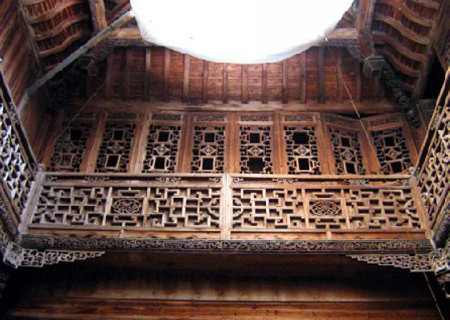(Ecns.cn)--Despite a history of almost 1,000 years and more than 60 well-preserved historic buildings dating from the Ming dynasty (1368 to 1644) to the Republic of China (1912 to 1949), Ge village in Zhenjiang city, Jiangsu Province, has been marked against its will for government demolition.
Last month, the Zhenjiang government announced a plan to remove the village and rebuild it as part of a new city district that would include housing estates and a lucrative industrial area.
The project was slated to start at the beginning of November, but has not yet begun however, leaving villagers in frightened limbo and some experts crying foul about economic development taking precedence over cultural relic protection.
There are currently 2,840 people living in Ge. Most of them are descendants of people who migrated from Shandong Province during the Song dynasty.
The ancestral hall of the Xie family is the landmark building in the village, where about 80 percent of the inhabitants bear the name Xie. Built in the Ming Dynasty and covering an area of 2,350 square meters, the hall is the village's oldest memorial temple, a municipally-protected site known for its excellent historic architecture.
"You can hardly find another hall as large as this one in such good condition," said Wang Yongping, an expert in historic and cultural relic protection in Nanjing, the capital of Jiangsu Province.
After the founding of new China, the hall was not only a place to memorialize ancestors; over the years it also served as a primary school, a village office and a shoe-making factory. In 2007, in order to protect the site, the Zhenjiang government injected 350,000 yuan (US$54,825) for repairs.
There are also more than 60 other historic buildings in the village, all valued as relics to local residents. At the entrance to the village there is a well built in the Song dynasty that can still be used, for example.
Although it has not gained the official title of "historical and cultural village," the locals do their best to protect the ancient structures it contains.
It was in July of 2010 that the Zhenjiang government listed 62 of Ge's historic buildings, and then claimed that it had applied for provincial government protection of them.
However, the residents were later told that the village did not qualify for the title and had failed the application. A puzzled Wang Yongping, who had already helped over 30 villages in Jiangsu Province apply for the title, asked why Ge had been turned down by the provincial government. The answer was they had never received an application from the village at all.
"With so many ancient constructions, well-preserved streets and roads, and native villagers, it should not have been hard for Ge to gain the title," said Wang after hearing this. It was apparent that the Zhenjiang government had rigged the result.
In 2009, Zhenjiang had already begun to speed up the pace of construction in the new district that would eventually overtake Ge village. If the village had been named an official historic site, it would have been difficult to remove and rebuild it according to the government's development plan.
In January 2010, Zhenjiang posted a map on its official website illustrating the future look of the new district. On the map, the village had been divided into two parts: one for industry and the other for living and entertainment.
On Oct.8, 2011, the Zhenjiang government posted notice of the removal of Ge village officially. And though the villagers refused to accept the decision, there it little they can do to stop it.
The ambitious plan to build a new Zhenjiang district equipped with various industrial gardens has overshadowed any government interest in historic preservation. Last January, a senior official responsible for the plan said that the new district would achieve a total output value of 50 billion yuan (US$7.83 billion) by the end of 2013.
Many believe that economic development should not come at the sacrifice of culture, however.
"Every village is a thick book with a plenty of stories to tell, and if the villages disappear, we will lose the chance the read the country," said Feng Jicai, a famous Chinese writer.
Yet Ge is only one of many such villages that have or will vanish beneath the bulldozer of China's race to gain ever higher levels of prosperity.


















